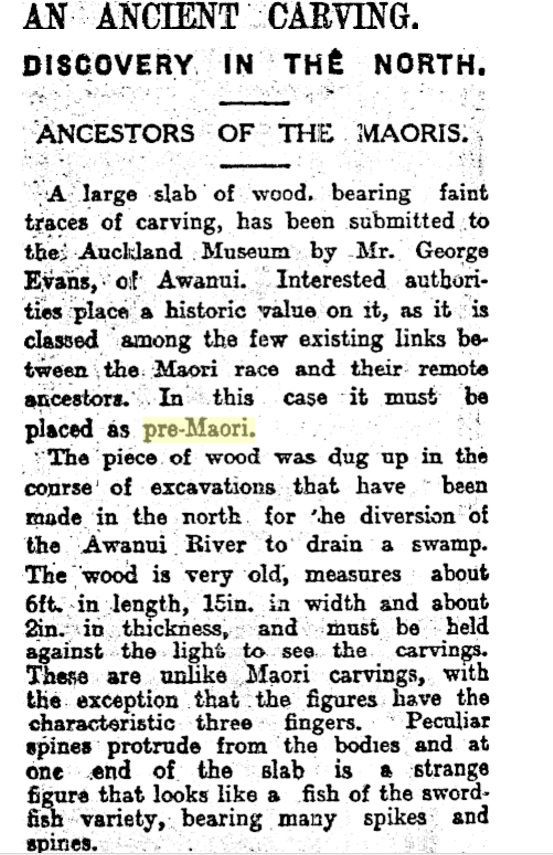84: The Awanui 'slab'
- IJ
- Feb 5, 2017
- 4 min read
We have been going through some old newspaper clippings from last century and beyond and posting them up on the Facebook page. Below is one that involved a story I was unaware of, even after learning as much as possible about everything discovered in and around Kaitaia. Kaitaia includes Awanui and Orongotea. Below is the clipping...

I was unable to find anything on this 'slab' until by accident I located a report that included these old photographs below. These photos are the only representations I can find of a little known (and apparently closely guarded) piece of NZ history. As far as we can tell they have never ever been on public display.

This carving is as un-Maori like as the Kaiatia carving is. Once again we point out that if this is an 'archaic' Maori carving (meaning it was carved soon after they arrived here), you have to ask what influenced the departure from their traditional styles back in Raiatea and elsewhere. The answer is obvious. These styles are not Maori but of a people thriving here before Polynesians and even Melanesians arrived. Polynesians did copy the local styles over a short period of time and developed them long after they had disposed of the original inhabitants in various pockets around Aotearoa - also the original name the true Tangata Whenua gave this land.
The carving in question was found during swamp draining work. Unfortunately the whole slab was not recovered and that is a shame as the most interesting portions would appear to be that which are missing...ie the heads of the human figures. Were they bird like? Other items in the far north have had birdlike heads on human figures. What other island has similar figures? Rapanui?
On the carvings rear are 10 small rectangular (not round) holes which are irregular and give no hint as to the slabs purpose. Note that the Kaitaia caving (see 19th January 2017) also has rectangular holes in it and sits on a rectangular base. Rectangles are not something seen in carvings of Polynesian peoples.
These carvings have body spikes or conical spines much like those of the Doubtless Bay canoe prow. Keep in mind that Doubtless Bay is only 20 miles away from where this was found. All these styles were from a people that lived from coast to coast in that region. I myself have found an ancient skeleton in Doubtless Bay with a human tooth necklace and an adze that is very ancient (predating anything else publically presented) and that in itself was found below the skeleton. Most artifacts belonging to individuals are alongside or on top of those buried. The skeleton and relevant items to it, were reburied in a safer location. But much of the area holds much more.

This slab formed part of something unknown. It's use and it's story it portrays is something of a mystery. It is a pity there has not been more found of it but in time more items will be dug up in the Northland area (and has been), that will be displayed to the public in due time. For north of Awanui is a large swampland that holds many secrets. Not of interest to us, is the relatively recent discovery of an old pa on an island within the river delta. Before much of the land around Kaitaia and environs was drained, the whole area looked like the current delta. To the untrained you would consider it a useless swamp. But to Maori and those here before them it was a means of sustaining life, easily defended, providing transport via watercraft and providing plentiful game and fish, as well as timber for carving because this was also where the Kauri and Totara forests grew between the waterways - timber that provided hardy material for carving as well as canoe manufacture. Is this reason why so many excellent carvings have been found there, the nature of the timber and the hiding of them in the swamp prior to attack by enemies.
So look at the figures above again. They are not Maori or even Polynesian like. Not from 1280 or onward anyway (1280 being the time Maori began their migrations). It does have a Manaia style which was common in Maori carvings in later years but unknown in Polynesia. It's obvious where they copied the designs from. This slab portion was hidden in a swamp to protect it. Protect it from whom? The Maori invaders. It was a sacred piece - as was the Kaitaia (or Orongotea) carving.
Once we have DNA and carbon dating proof of the actual bones, we can challenge current belief on the origin of things not typical of the Polynesian immigration styles. And that is our purpose. Not to present unusual Maori items (as fascinating and beautiful as many of them are) but the origins of those here first - those here before those who say they were first.
Not buying our theory? Look at the carvings above again - but closely.
***
UPDATE: 30th March 2017 - Here is a photo I had taken some time ago. I had forgotten I'd taken it. It was on display at the Auckland Musuem after all but I'm not sure if it still is?

















































Comments